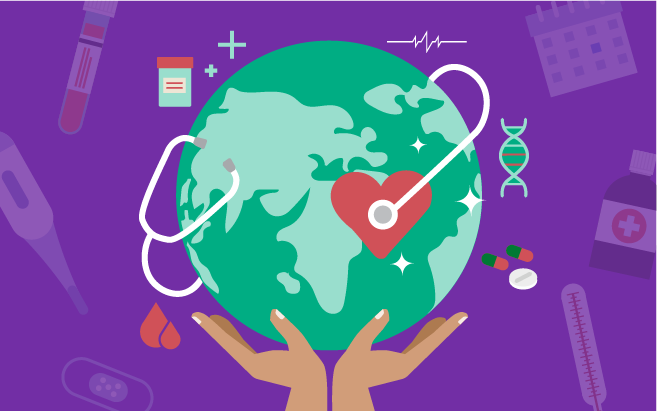Global inequalities in cancer – the numbers
Incidence of cancer is increasing globally. International cancer data taken from Globocan demonstrates that cases will increase from 19m in 2020 to nearly 29m by 2040.
The number of new cases is increasing most rapidly in countries with a low Human Development Index (HDI). Globocan estimates that cases will increase by 96% between 2020 and 2040 among low HDI countries, compared with an increase of only 32.2% in very high HDI countries.
What is the Human Development Index?
The World Health Organization (WHO) defines the HDI as a combined measure of how well a country is doing in the following categories:
- Life expectancy at birth – useful for determining whether a population/individual can live a long and healthy life.
- Education and knowledge – measured by reporting the mean years of education that a population receives and the expected years of education.
- Standard of living and financial wealth – assessed by how much a currency can buy compared with an international comparison – usually the US dollar.
Cancer can have a significant impact on an individual’s likelihood of living a long life, as well as a life free of disability. It’s estimated that, globally, cancer caused 250m disability-adjusted life years (DALYs) in 2019. Cancer was the leading cause of DALYs in wealthier countries, compared with 10th in those that were less wealthy. As cases of cancer continue to increase in countries with a low HDI, increasing numbers of DALYs are likely (see more on DALYs).
A leading cause of mortality
Globally, cancer is the 2nd leading cause of mortality after cardiovascular disease, and it’s the leading cause of death in over 50 countries. In 2020 there were nearly 10m deaths from cancer globally, with this figure expected to increase to 16m by 2040. The burden of cancer continues to have an impact on individuals, communities and healthcare systems around the globe – an impact that is likely to grow as incidence and mortality continue to increase.
Because of this, preventing those cancers that are associated with modifiable risk factors is a key priority for World Cancer Research Fund.
As with incidence, mortality from cancer is increasing most rapidly in countries with a low HDI. Globocan estimates an increase of 98.4% in these countries in 2020–40, compared with 42.5% in those with a very high HDI.
It’s important to note that cancer incidence and mortality are increasing in all regions – but significantly more in low- and middle-income countries. This is partly because the global population continues to grow and age, with age being the most significant risk factor for cancer.
But what other factors contribute to the differences in the increase in cancer we see between richer and poorer settings?
Differences in modifiable risk factors
Approximately 40% of cancers are attributable to modifiable (sometimes referred to as lifestyle) risk factors and could be prevented. The leading modifiable risk factors are smoking – which accounts for half of all preventable cancer – alcohol and obesity. Approximately 15% of preventable cancers are caused by diet, nutrition, physical activity and obesity, and through its Global Cancer Update Programme, World Cancer Research Fund is working to understand how these are affected by health inequality.
While smoking continues to decline in developed countries, rates are climbing in less developed countries – 80% of people who consume tobacco products live in low- and middle-income countries.
World Cancer Research Fund also works to influence policy that creates healthier environments, enabling people to follow our Cancer Prevention Recommendations. See our NOURISHING and MOVING frameworks for key areas where governments need to take action to promote healthier diets and increased physical activity, and to reduce obesity.
Disparities in cancer screening and treatment
There are significant disparities across the globe in who can access cancer services, including screening and treatment. In some regions this is because the infrastructure to provide these services doesn’t exist, while in others it’s because the services are too expensive for some people to use.
We know that screening can diagnose cancer at an earlier stage, so when screening services are unavailable or inaccessible, cancer is likely to be diagnosed at a later stage. This reduces the likelihood that a person will survive cancer.
The same is true for cancer treatment: if people cannot access treatment, they are unlikely to have a long life expectancy once diagnosed.
There are also factors at the personal and cultural level which affect a person’s decision to access healthcare – these include attitudes towards healthcare and low knowledge of cancer.
> More on why cancer survival rates vary across countries
Globocan
Globocan is an online database of publicly available global cancer statistics and estimates of cancer incidence and mortality in 185 countries for 36 site-specific cancers, produced by the International Agency for Research on Cancer.
What is a DALY?
DALYs allows us to measure the overall burden of disease within a population. The WHO defines a DALY as “a time-based measure that combines years of life lost due to premature mortality and years of life lost due to time lived in states of less than full health, or years of healthy life lost due to disability”.
Read our blog series on health inequality and cancer
> ‘Don’t blame the poor, blame poverty’: understanding health inequalities in cancer
> World Cancer Day 2023: how we’re working to prevent cancer worldwide

